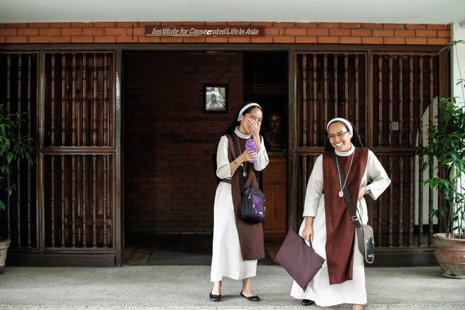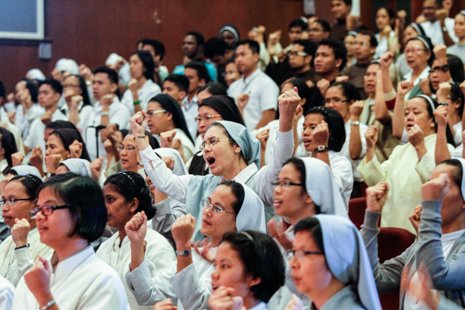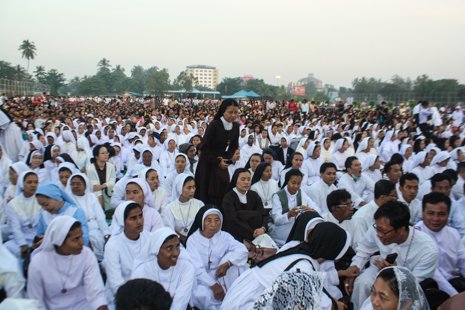Facing the future for religious in Southeast Asia
Facing the future for religious in Southeast Asia. Education, attracting young people are key challenges in the region

Sisters share a light moment at the Institute for Consecrated Life in Asia in Manila. (Photo by Joe Torres)
Pope Francis declared that 2015 would be an international Year of Consecrated Life. In a series of features, ucanews.com explores the status of religious life throughout the regions we cover, beginning today with Southeast Asia, then followed by East Asia and South Asia.
Sister Margaret Maung doesn't wear a nun's habit, but a traditional "longyi" and a simple blouse.
Experience has taught her to embrace Myanmar's cultural dress even while representing her faith.
"It helps a lot when we reach out to people," says Sr Margaret, an ethnic Chin and a missionary with three decades of experience.
Sr Margaret works with poor women, especially Muslims and Buddhists in the southern part of Myanmar. Her congregation tries to educate women about human trafficking and HIV/AIDS. For her, teaching life skills to women is part of a “new evangelization”.
“We never talk about religion, and we witness to non-Christians through our good deeds,” says the missionary nun, who is the provincial superior of the Sisters of Our Lady of the Missions in Myanmar.
This week, members of the Federation of Asian Bishops' Conferences are gathering in Thailand. The symposium’s theme is “consecrated life at the service of new evangelization”.
The discussion comes at a pivotal time for religious men and women in Southeast Asia. Religious have always been at the forefront of the Church’s mission in many parts of the region. Yet today, religious men and women find themselves facing new challenges to their lives and missions.
Apart from the Philippines and Timor-Leste, Catholics in Southeast Asia exist as a minority in countries where other faiths dominate.
Like the institutional Church itself, religious life in the region is still largely considered foreign or Western, says Claretian Fr Samuel Canilang, director of the Institute for Consecrated Life in Asia (ICLA).
“It still has to prove its ‘Asian-ness’,” he says.
Jesuit Fr Jose Quilongquilong says the declaration of 2015 as the “Year of Consecrated Life,” is an opportunity for the religious to reflect on their “identity, lifestyle and mission”.
"What is our identity now in this world of globalization? What is our identity as religious in Asia?" asks the president of the Loyola School of Theology in Manila.
For him, the religious identity is “prophetic” in a world of “secularism, individualism and autonomy”.
“We proclaim Christ in the context of so many challenges,” he says.

Nuns join in singing at a meeting of religious priests and nuns in Manila in July. (Photo by Joe Torres)
Learning from the lessons of history
The first religious orders to arrive in the Philippines were the Augustinians in 1565. The Franciscans followed in 1578, the Jesuits in 1581, the Dominicans in 1587, and the Augustinian-Recollects in 1606.
It is a rich history. But in order to plan for the future, Filipino religious must first acknowledge the past, says Dominican Fr Rolando de la Rosa, former rector of the 400-year old University of Santo Tomas.
“How can we be proud of the past in which the Filipino religious were hardly present?” he asks.
Today, he says, the country has just over 7,300 priests. Of the roughly 2,300 religious priests, about 1,300 are Filipinos.
The Philippines until recently could claim to be Asia's only Catholic country. But Fr de la Rosa argues that the high number of foreign religious priests means that the country remains a mission territory.
“That is very ironic,” he says. “We are being asked to go abroad and preach the gospel, evangelize in other countries, when in fact our country itself is a mission territory.”
The task now, he says, is to learn from the past as Filipino religious look to the future.
"We look back, yes, with gratitude, but we have to learn lessons from history so we will not repeat the mistakes," Fr de la Rosa says.
Renewal
In Indonesia, there is an increase in the number of men and women who are embracing the religious life and those entering the priesthood since 1962, when the Indonesian bishops' conference was established.
Franciscan Fr Adrianus Sunarko, chairman of the Conference of Religious Superiors of Indonesia, however, notes that most religious are in their late 40s, while the number of young people embracing the religious life is declining.
Sunarko blames the religious' “lack of testimony and promotion” of vocations for the decline in the number of young people joining congregations.
“Young people do not recognize their work,” Fr Sunarko says. “People are not impressed with what they do.”
However, the number of young people joining diocesan seminaries has increased.
Indonesia has some 2,000 diocesan priests, many of whom are in their 30s. In recent years, the local Church saw the ordination of about 300 priests every year, while at least 2,500 seminarians are studying in 14 major seminaries.
But Fr Siprianus Hormat, executive secretary of Indonesia's Commission for Seminaries, admits that the local Church has to focus on the formation of young priests because of their “tendency toward the hedonistic lifestyle”.

Religious sisters seen at a celebration of Catholicism in Myanmar, taken in Yangon in November. (Photo by John Zaw)
Political reforms, religious decline?
In Myanmar, the government’s ongoing quasi-democratic reforms may be impacting young people’s interest in joining the religious life.
Sr Rita Phyo, executive secretary of the Catholic Religious Conference of Myanmar, says the improvement in Myanmar's political situation offers more options for the country’s younger generation.
“As there is political openness and young people have opened their eyes, they leave the country for job opportunities,” she says.
Recent data shows that there are about 2,700 religious women and 321 men in Myanmar, with an average age of 40 years.
Vietnam is a different story. Fr Joachim Nguyen Huu Van of the Institute of the Heart of Jesus says vocations are thriving, particularly in northern Vietnam.
"We have many priests. In one diocese alone there are 200 priests and about 200 seminarians every year," Fr Huu Van says.
But despite the historical prominence of religious in Vietnam, the environment today is one that is tightly controlled.
Most religious are limited to charity work, such as in orphanages, in homes for the elderly, and in teaching catechism to children, Fr Huu Van says.
“We hope that in the future, the government will open doors for the religious to open schools,” he says, while expressing hope that Vietnam will in the future contribute missionaries to places like China, Laos, and Cambodia.
In Thailand, where Catholics make up a small minority of the population, Church officials say consecrated people have an especially vital role to play.
“Vocations on the whole are decreasing but this can be countered only if consecrated people recommit themselves and improve the way they follow this commitment,” says Bishop Silvio Siripong Charatsri of Chanthaburi.
“It is not enough for consecrated people to just instruct but to actually prove to be a witness to what they believe in.”
Education
Moving forward, education remains a key challenge that will determine the future of religious men and women in Southeast Asia.
Samuel Canilang of the ICLA, who is also dean of graduate studies in a seminary in Manila, says there is a scarcity of qualified and experienced “formators, spiritual guides and professors”, particularly in "emergent Churches" like Vietnam, Myanmar, Laos, and Cambodia.
"We are dealing with young people who are very different in many aspects compared with those in the past," he says.
Today’s aspirants to the religious life, he says, must be prepared for missions in "contexts of ever increasing complexity".
Similarly, providing a quality education to society at large in Southeast Asian countries will remain a vital part of the “new evangelization”.
"We look on the Catholic higher education institutions as among God’s precious gifts both to the Church and society," says Archbishop Socrates Villegas of Lingayen-Dagupan, president of the Philippine bishops' conference.
"Education is important and it costs, but it's also a way to help the poor by providing the best education the country needs," says Quilongquilong. “To really serve the poor, we need to strengthen education.”
With additional reporting by John Zaw in Mandalay, Siktus Harson in Jakarta and Ivan Fernandes in Pattaya.


 Votes : 0
Votes : 0









